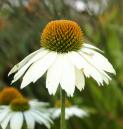Ol. Lavand. [Oleum Lavandulae Florum, U.S. P. VIII]
Related entry: Lavender
"A volatile oil distilled from the fresh flowering tops of Lavandula vera De Candolle (Lavandula officinalis Chaix, Lavandula spica Linné) (Fam. Labiatae). Preserve it in well-stoppered, amber-colored bottles, in a cool place, protected from light." U. S. "The oil distilled from the flowers of Lavandula vera, DC." Br.
Huile volatile de Lavande officinale, Fr. Cod.; Essence de Lavande, Fr.; Oleum Lavandulae, P. G.; Lavandelöl, G.; Essenza di lavanda, It.; Esencia de espliego, Sp.
This oil is usually distilled from the flowers and flower stems conjointly, though of finer quality when obtained from the former exclusively. Dried lavender flowers are said to yield from 1 to 1.5 per cent. of oil. According to Zeiler, the fresh flowers yield 1.03, the dried 4.3, the whole fresh herb in flower 0.76 per cent. It is stated that the lavender produced by an acre of ground under cultivation will yield from 10 to 12 pounds of the oil. (P. J., 1864, p. 257.) The oil is very fluid, of a lemon-yellow color, with the fragrance of the flowers and an aromatic, burning taste. That met with in commerce has the sp. gr. 0.898 at 20° C. (68° F.), which is reduced to 0.877 by rectification (Berzelius), or 0.886 (Buignet). It is laevogyrate. According to Brande, the sp. gr. of the oil obtained from the whole herb is 0.9206. Alcohol of 0.830 dissolves oil of lavender in all proportions, that of 0.877 only 42 per cent. (Berzelius.) Proust states that when allowed to stand in imperfectly stoppered bottles it lets fall a crystalline deposit, which often amounts to one-fourth of its weight. This has been found by Dumas to have the same point of volatilization and the same composition as true camphor, but to differ in the total want of rotatory power. It is said that the portion of oil first distilled is most fragrant, and is often kept separate, and sold at a, higher price. "Oil of Lavender is a colorless or yellow liquid, having the characteristic odor and taste of lavender flowers. It is soluble in 3 volumes of 70 per cent. alcohol. Specific gravity: 0.875 to 0.888 at 25° C. (77° F.). The optical rotation varies from -1° to -10° in a 100 mm. tube at 25° C. (77° F.). When shaken in a narrow glass cylinder with an equal volume of distilled water, its volume does not diminish (alcohol). Shake 20 mils of the Oil with 40 mils of 5 per cent. alcohol and, when the mixture has cleared, withdraw 30 mils of the alcoholic solution. Neutralize this with (half-normal potassium hydroxide V.S., using phenolphthalein T.S. as indicator, then add 5 mils of half-normal potassium hydroxide V.S. and heat the mixture on a water-bath, under a reflux condenser, during one hour. Not less than 4.7 mils of half-normal hydrochloric acid V.S. is required for neutralization (foreign esters)." U. S.
"Pale yellow or yellowish-green. Odor that of the flowers; taste pungent, slightly bitter. Specific gravity 0.883 to 0.900; optical rotation -3° to -10°. Soluble in 4 parts of alcohol (70 per cent.). Contains from 7 to 11 per cent. of esters (English oil), or not less than 30 per cent. of esters (foreign oil), calculated as linalyl acetate, C10H17C2H3O2." Br.
The principal constituent is an alcohol, C10H18O, identical with the linalool. Besides lina-lool, lavender oil contains linalyl acetate (from 30 to 45 per cent. in the oil from French flowers, and from 7 to 10 per cent. in the oil from English flowers), the butyric ester of the same alcohol, geraniol, a very small amount of cineol (more in the English than in the French oil), and sometimes traces of pinene, limonene, and a sesquiterpene.
Oil of Spike is procured from the broad leaved variety of lavender which grows wild in Europe, the Lavandula Spica of De Cavanilles. Its odor is less fragrant than that of common oil of lavender, and is somewhat analogous to that of oil of turpentine, with which it is said to be often adulterated. It is used by artists in the preparation of varnishes. The oil of spike contains about 30 per cent. of cineol and but small quantities of esters. Oil of lavender is used chiefly as a perfume, though possessed of carminative and stimulant properties, and sometimes useful in cases of nervous languor and headache.
Dose, from one to five minims (0.06-0.3 mil).
Off. Prep.—Spiritus Lavandulae, U. S., Br.; Tinctura Lavandulae Composita, U. S., Br.; Acetum Aromaticum, N. F.; Spiritus Odoratus, N. F.

